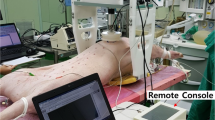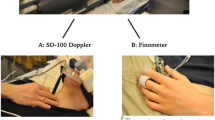Abstract
Whether blood flow during cardiopulmonary resuscitation (CPR) results from intrathoracic pressure fluctuations or direct cardiac compression remains controversial. We developed a mathematical model that predicts that blood flow due to intrathoracic pressure fluctuations should be insensitive to compression rate over a wide range but dependent on the applied force and compression duration. If direct compression of the heart plays a major role, however, the model predicts that flow should be dependent on compression rate and force, but above a threshold, insensitive to compression duration. These differences in hemodynamics produced by changes in rate and duration form a basis for determining whether blood flow during CPR results from intrathoracic pressure fluctuations or from direct cardiac compression. The model was validated for direct cardiac compression by studying the hemodynamics of cyclic cardiac deformation following thoracotomy in four anesthetized, 21–32-kg dogs. As predicted by the model, there was no change in myocardial or cerebral perfusion pressures when the duration of compression was increased from 15% to 45% of the cycle at a constant rate of 60/min. There was, however, a significant increase in perfusion pressures when rate was increased from 60 to 150/min at a constant duration of 45%. The model was validated for intrathoracic pressure changes by studying the hemodynamics produced by a thoracic vest (vest CPR) in eight dogs. The vest contained a bladder that was inflated and deflated. Vest CPR changed intrathoracic pressure without direct cardiac compression, since sternal displacement was <0.8 cm. As predicted by the model and opposite to direct cardiac compression, there was no change in perfusion pressures when the rate was increased from 60 to 150/min at a constant duration of 45% of the cycle. Manual CPR was then studied in eight dogs. There was no surgical manipulation of the chest. Myocardial and cerebral blood flows were determined with radioactive microspheres and behaved as predicted from the model of intrathoracic pressure, not direct cardiac compression. At nearly constant peak sternal force (378–426 N), flow was significantly increased when the duration of compression was increased from short (13%–19% of the cycle) to long (40%–47%), at a rate of 60/min. Flow was unchanged, however, for an increase in rate from 60 to 150/min at constant compression duration. In addition, myocardial and cerebral flow correlated with their respective perfusion pressures. Thus vital organ perfusion pressures and flow for manual external chest compression are dependent on the duration of compression, but not on rates of compression of 60 and 150/min. These data are of course similar to those produced by vest CPR, where intrathoracic pressure is manipulated without sternal displacement, and to those predicted for movement of blood by intrathoracic pressure changes. These data are, however, opposite to those produced by cardiac deformation and to those predicted for movement blood by direct cardiac compression. We conclude that intrathoracic pressure fluctuations generate blood flow during manual CPR.
Similar content being viewed by others
Abbreviations
- P :
-
pressure
- PE:
-
external pressure
- P tm :
-
transmural pressure
- C :
-
compliance
- V :
-
volume
- Vo:
-
unstressed volume
- Q :
-
flow
- R :
-
resistance
References
Babbs, C., J.C. Weaver, S. Ralston and L. Geddes. Cardiac, thoracic, and abdominal pump mechanisms in cardiopulmonary resuscitation: Studies in an electrical model of the circulation.Am. J. Emerg. Med. 2:299–306, 1984.
Beyar, R., Y. Kishon, S. Sideman and U. Dinnar. Computer studies of systemic and regional blood flow mechanisms during cardiopulmonary resuscitation.Med. Biol. Eng. Comp. 22:499–507, 1984.
Cohen, J.M., N. Chandra, P.O. Alderson, A. Van Aswegen, J. Tsitlik and M.L. Weisfeldt. Timing of pulmonary and systemic blood flow during intermittent high intrathoracic pressure cardiopulmonary resuscitation in the dog.Am. J. Cardiol. 49:1883–1889, 1982.
Fisher, J., F. Vaghaiwalla, J. Tsitlik, H. Levin, J. Brinker and M.L. Weisfeldt. Determinants and clinical significance of jugular venous valve competence.Circulation 65:188–196, 1982.
Fitzgerald, K.R., C.F. Babbs, H.A. Frissora, R.W. Davis and D.I. Silver. Cardiac output during cardiopulmonary resuscitation at various compression rates and durations.Am. J. Physiol. 241:H442–H448, 1981.
Guerci, A., A-Y. Shi, H. Levin, J. Tsitlik, M.L. Weisfeldt and N. Chandra. Transmission of intrathoracic pressure to the intracranial space during cardiopulmonary resuscitation in dogs.Circ. Res. 56:20–30, 1985.
Halperin, H., H. Levin and J. Tsitlik. Integrated real-time data acquisition and control system.IEEE Frontiers Eng. Comput. Health Care 5:483–486, 1983.
Halperin, H., J. Tsitlik, A. Guerci, E.D. Mellits, H. Levin, A-Y, Shi, N. Chandra and M.L. Weisfeldt. Determinants of blood flow to vital organs during cardiopulmonary resuscitation in dogs.Circulation 73:539–550, 1986.
Koehler, R., N. Chandra, A. Guerci, J. Tsitlik, R. Traystman, M. Rogers and M.L. Weisfeldt Augmentation of cerebral perfusion by simultaneous chest compression and lung inflation with abdominal binding after cardiac arrest in dogs.Circulation 67:266–274, 1983.
Kouwenhoven, W.B., J.R. Jude and G.G. Knickerbocker. Closed chest cardiac massage.JAMA 173:1064–1067, 1960.
Laks, M.M., D. Garner and H.J.C. Swan. Volumes and compliances measured simultaneously in the right and left ventricles of the dog.Circ. Res. 20:565–569, 1967.
Mackenzie, G., S. Taylor, A. McDonald and K. Donald Hemodynamic effects of external cardiac compression.Lancet 1:1342–1345, 1964.
Maier, G.W., G.S. Tyson, C.O. Olsen, K.H. Kerstein, J.W. Davis, E.H. Conn, D.C. Sabiston, Jr., and J.S. Rankin. The physiology of external cardiac massage: high-impulse cardiopulmonary resuscitation.Circulation 70:86–101, 1984.
Marini, J.J., B.H. Culver and J. Butler. Effect of positive end-expiratory pressure on canine ventricular function curves.J. Appl. Physiol. 51:1367–1375, 1981.
McMahon, S.M., S. Permutt and D.F. Proctor. A model to evaluate pleural surface measuring devices.J. Appl. Physiol. 27:886–894, 1969.
Michael, J.R., A. Guerci, R. Koehler, A-Y. Shi, J. Tsitlik, N. Chandra, M. Rogers, R. Traystman and M.L. Weisfeldt. Mechanisms by which epinephrine augments cerebral and myocardial perfusion during cardiopulmonary resuscitation in dogs.Circulation 69:822–834, 1984.
Niemann, J.T., J.P. Rosborough, M. Hausknecht, D. Garner and J.M. Criley. Pressure synchronized cineangiography during experimental cardiopulmonary resuscitation.Circulation 64:985–991, 1981.
Prewitt, R.M. and L.D.H. Wood. Effect of positive end-expiratory pressure on ventricular function in dogs.Am. J. Physiol. 236:H534–H540, 1979.
Rankin, J.S., C. Olsen, C. Arentzen, G. Tyson, G. Maier, P. Smith, J. Hammon, J. Davis, P. McHale, R. Anderson, and D.C. Sabiston, Jr. The effects of airway pressure on cardiac function in intact dogs and man.Circulation 66:108–120, 1982.
Rudikoff, M.T., W.L. Maughan, M. Effron, P. Freund and M.L. Weisfeldt. Mechanisms of blood flow during cardiopulmonary resuscitation.Circulation 61:345–352, 1980.
Shoukas, A.A. Pressure-flow and pressure-volume relations in the entire pulmonary vascular bed of the dog determined by two-port analysis.Circ. Res. 37:809–818, 1975.
Smiseth, O.A., M.A. Frais, I. Kingma, E.R. Smith and J.V. Tyberg. Assessment of pericardial constraint in dogs.Circulation 71:158–166, 1985.
Weale, F.E. and R.L. Rothwell-Jackson. The efficiency of cardiac massage.Lancet 1:990–992, 1962.
Yin, F.C.P., J.M. Cohen, J. Tsitlik, B. Zola and M.L. Weisfeldt. Role of carotid artery resistance to collapse during high-intrathoracic-pressure CPR.Am. J. Physiol. 243:H259–H267, 1982.
Author information
Authors and Affiliations
Rights and permissions
About this article
Cite this article
Halperin, H.R., Tsitlik, J.E., Beyar, R. et al. Intrathoracic pressure fluctuations move blood during CPR: Comparison of hemodynamic data with predictions from a mathematical model. Ann Biomed Eng 15, 385–403 (1987). https://doi.org/10.1007/BF02584292
Issue Date:
DOI: https://doi.org/10.1007/BF02584292




